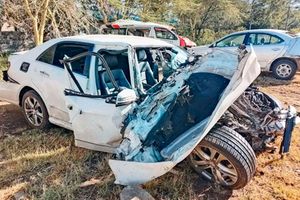Premium
Uhuru’s legacy: Fact-checking the President

President Uhuru Kenyatta making his Madaraka Day speech.
President Uhuru Kenyatta used his last Madaraka Day speech to highlight his achievements as he nears the end of his nine-year tenure, and took ample time to tell his detractors that his legacy was secure and that his successes would outlive him.
Considered the jewel in the crown of the Jubilee administration’s successes, the Head of State seized the opportunity to highlight his mega infrastructure projects, including the multi-billion-shilling Chinese-funded Standard Gauge Railway (SGR), the newly-built Nairobi Expressway and the Lamu Port.
The Nation fact-checked President Kenyatta’s claims.
Claim One
He also boldly declared that his administration had built more tarmac roads than his three predecessors combined, in addition to a list of his other successes.
“I am proud to record that, if the third administration built 2,000 kilometres of tarmac roads, we accelerated his achievement by building over 11,000km, which is close to six times what they built. In fact, we have built more roads in nine years than what the previous administrations combined, including the colonisers, built in 123 years,” said President Kenyatta.
FACT CHECK
Data from the Kenya National Bureau of Statistics (KNBS) shows that by December 2012, just shortly before President Kenyatta was elected into office, Kenya had built 9,700km of tarmac roads since the pre-colonial era.
By December last year, Kenya’s tarmac road network had more than doubled, to 21,826km, an increase of 12,126km during his tenure, even though some of the roads were conceived, budgeted for and funded by the administration of the late President Mwai Kibaki.
VERDICT: CORRECT
Claim Two
The President also spoke of his achievements in the education sector, where he said he had prioritised the growth of higher education to prepare learners for a knowledge-based economy and to nurture talents and a workforce that is globally competitive.
He also reminded his naysayers that “there is no turning back now” from the competency-based curriculum (CBC) “given the manifest successes achieved in this short period of time”.
“To ensure that even those that are not admitted in universities get an equal chance, we have transformed our Technical and Vocational Education Training (TVet). Where there stood only 52 institutions in 2013, today we are home to 238 institutes, representing a 435 per cent growth. With this transformation, every Kenyan child has a chance,” he said.
FACT CHECK
Official data shows that there were 705 TVet institutions in the country by December 2012, which had grown to 2,396 institutions by the end of last year.
VERDICT – UNDERSTATED
Claim Three
Continuing his list of achievements in the education sector, the Head of State said his administration had achieved a 100 per cent transition rate of students from primary school to secondary school, and had also achieved the book-to-child ratio of 1:1.
“With the mandate you gave me, we also secured 100 per cent transition from primary to secondary education, ensuring that no-child is left behind. We have also achieved Africa’s first 1:1 child to book ratio and restored the integrity of our national examinations.”
FACT CHECK
However, official data shows that instead of achieving that full transition rate, the ratio of students joining secondary school from primary school has instead fallen sharply over the past year.
Data from KNBS shows the transition rate fell from 91 per cent in 2020 to 78.5 per cent last year, the lowest transition rate in five years, and far lower than the President’s claim.
VERDICT – INCORRECT
Claim Four
Regarding the level of textbooks available to students, data from the National Treasury shows that the student-to-book ratio in secondary school has been achieved in 20 subjects in 97 per cent of schools and not all schools.
VERDICT – LARGELY CORRECT
Claim Five
President Kenyatta also said that diaspora remittances into the country have grown 10 times since he came into power, a growth he said underlines his government’s successes in growing Kenya’s stature globally and, therefore, enhancing opportunities for Kenyans abroad.
“In return, diaspora remittances have increased tenfold in the last decade; and they now stand at an all-time-high of over Sh400 billion in 2021; surpassing traditional exports and making human capital our greatest export,” he said.
FACT CHECK
Kenya’s diaspora remittances have grown exponentially in recent years, driven by the growing Kenyan population abroad, as well as the growth of mobile money and alternative money transfer channels that have eased cross-border money transfers.
Official data shows the remittances stood at Sh413.3 billion by the end of last year, and have long surpassed traditional heavyweights such as tea, coffee, flowers and tourism as Kenya’s largest source of foreign exchange.
When he came to power, the remittances stood at Sh98.85 billion in 2012, which means the inflows have grown by 4.5 times and not 10 times as claimed by the President.
VERDICT – PARTIALLY CORRECT
Claim Six
To rid the rot from Kenya’s cartel-laden land sector, President Kenyatta said his government’s reforms in the lands registry including digitisation meant to stamp out fake title deeds and reversing fraud have been successful.
He said that while it would take about six months to complete a land transaction in the past, this has now been reduced to just 48 hours using the new digital land registry called Ardhi Sasa.
FACT CHECK
The Ministry of Lands has been piloting the system in Nairobi over the past year with all land-related transactions in the city moved online, stopping physical transactions. However, Kenyans are still sceptical of the system amid a fight back from land cartels that want to maintain physical land deals.
Less than 10 per cent of the 40,000 properties currently guaranteed as ready to be uploaded live on the system have moved there, which means only a small proportion of land deals are happening through the system.
VERDICT – LARGELY CORRECT





